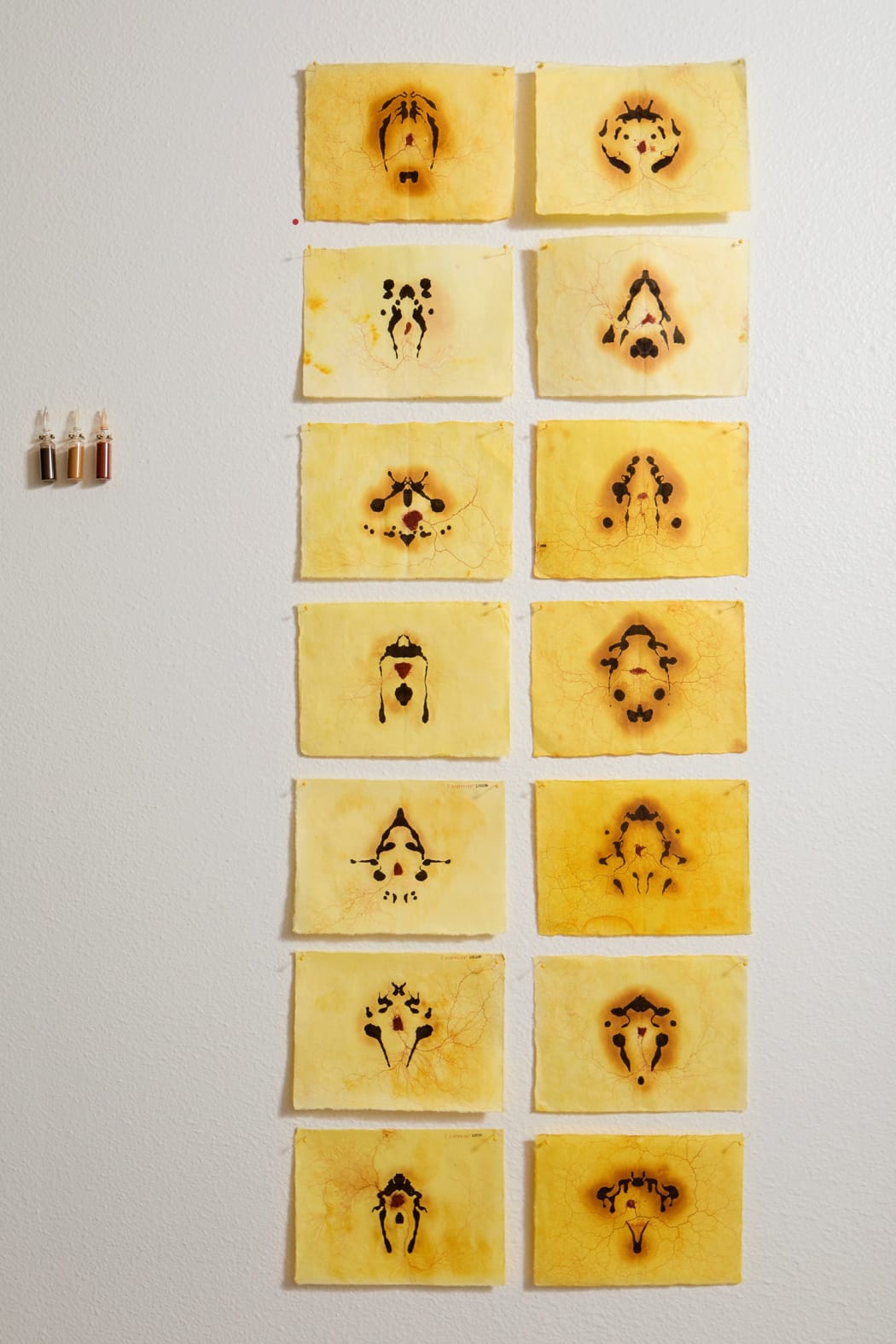
This is how Thomas Little, a poet and artist, describes his long-running series of slime mold collaborations: “An inkblot made with gun-derived magnetite and doped with valerian root extract operates as a negative chemotactic stimulus for Physarum polycephalum, a large primordial amoeba that is inoculated with gun-derived red iron oxide. A kind of ghost anatomy, hovering in the liminal space between living organism and supernatural entity.”
Little's work appears in Wild Pigment Project, a group exhibition that's on view at form & concept through early December. The international show (and the project that inspired it) promotes ecological balance and regenerative economies through a passion for wild pigments, their places of origin, and their cultural histories. Read an interview between Wild Pigment Project curator Tilke Elkins and Little here, and check out more words from the artist below.
Artist Statement
A holistic approach is central to my process. My work is rooted in an intimate involvement with material. I use a restricted palette of pigments, mostly fabricated from very psychically charged objects: handguns. Through chemical and alchemical means, these objects are transmuted into iron oxide pigments, including Black Iron Oxide (Mars Black, magnetite, lodestone) and Red Iron Oxide (Mars Red, red ochre, Saffron of Mars). The primacy these two colors play in human perception, compounded with the ancient associations with Iron as well as their origin as weapons, make them ideal in constructing objects that resonate with a specific intersectionality.
The first component created is an inkblot using Black Iron Oxide ink doped with Valerian Root extract. A series of these are made for fractal dimension analysis. I take advantage of studies utilizing decades of data culled from Rorschach Test results to achieve this. To briefly explain, a box counting algorithm is used to calculate the fractal dimension of the inkblot. This value, between 1 and 2, is compared to the amount of percepts ("things" perceived) found in the original Rorschach Test blots. The data concludes that inkblots with a fractal dimension around 1.1 yield the most percepts. After using software to obtain the fractal dimension of my inkblots, I use this value to calibrate a visual instrument that could potentially yield the most percepts. In this way, one can gauge the "hauntedness" of the blot. I call this the Induction Resonator.
Engineered within this inkblot is a hollow, a "corpus cava" into which the next component is placed. This is a small portion of oat gruel impregnated with Red Iron Oxide. Atop this is placed a live culture of Physarum polycephalum, an ancient organism commonly known as slime mold. Technically, Physarum is not a mold, but a population of amoebae that engages in incredibly sophisticated behaviors. It is truly a Protean creature. Through its collective action, it seems to exhibit intelligent behavior. It can solve mazes, learn through habituation and external memory, and merge with other populations and imbue them with the knowledge it has collected. It also can be a pigment vehicle. It leaves the gun-derived Red Iron Oxide, along with other waste, embedded in the slime trails it leaves behind as its external memory. By coloring the slime trails, it can leave a record, visible to the human eye, of its decisions.
Here is where the Valerian Root extract comes into play, acting as a chemotactic agent, which is to say, influencing the slime mold's behavior through chemical components. The population I work with is repulsed by Valerian Root, causing the slime to navigate around such stimuli. In its exploration of the inkblot, it leaves behind a record, in red, of its interpretation of its environment. An interpretation of an inkblot. The living slime mold is then evacuated from the paper.
With the two components combined, the resulting image becomes a kind of ghost anatomy, a partially realized creature, hovering in the liminal space between living organism and supernatural entity. A fossil of something yet to be, made from the Iron of weapons yielding to earth. It is simultaneously visceral and ethereal, suggesting both birth and death. They are a dialogue of form between an ancient creature that flows like blood and a spectral vision, its symmetry casting shadows of ancient predators and visages of edifying ancestors. They are totemic psychopomps, devices designed to unsettle so that we may re-evaluate, and see deeper in all directions.
Artist Bio
Thomas Little is an ink and pigment maker operating out of rural North Carolina. Central to his practice is the dissolution of firearms to create iron based pigments. With these materials, he experiments within the traditional arts of drawing, painting and printmaking, and also performs scientific experiments, which include using his iron oxide pigments as a recording medium for sound and also as a method of staining slime mold mucus trails. He has contributed his creations to the material libraries of universities, curated exhibits on pigment making and taught numerous workshops on pigment practices.
